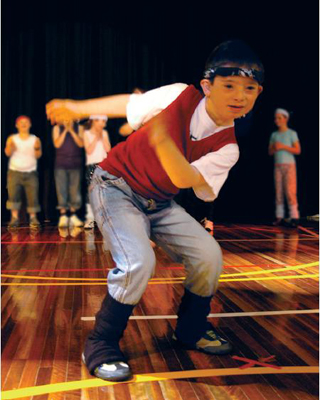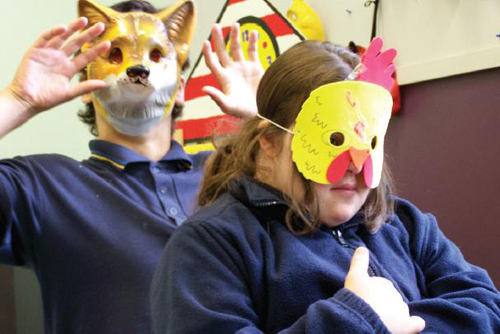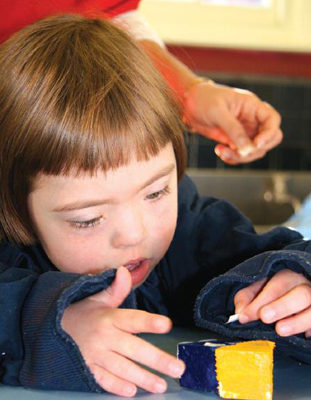
There are over 400 special schools in Australia, educating around 20 percent of the 150,000 students with special educational needs or a disability who are enrolled in schools nationally. The other 80 percent are enrolled in mainstream schools.
A new book published by the Australian Council for Educational Research (ACER), An Extraordinary School: Re-modelling Special Education, tells the story of the innovative Port Phillip Specialist School in Melbourne. The school, which caters to children aged two to eighteen years with a wide range of severe disabilities, has set high standards of best practice in special education models in that country. Today in The Global Search for Education series, I discuss how this pioneering model approaches special education for children with the book’s editor, award-winning foreign correspondent and mother of a child at the school, Sara James, and Robert Newall, the school’s principal.
Sara, how does the Port Phillip model improve on other specialist school models?
The reason Port Phillip Specialist School (the PPSS) is extraordinary by any international measure is a result of the trio of philosophies at its core, as well as the diversity and excellence of its staff and facilities.
Firstly, the school is fully serviced — meaning it has a wide-ranging staff of teachers, therapists, specialists, a social worker, psychologists, and other experts all available under one roof. That is unusual in a specialist school. Secondly, the school offers an integrated approach, overseen by a central committee. Scarce resources such as occupational or speech therapy are integrated in various ways so that they are spread throughout the day. Furthermore, the staff work together to ensure that they meet the needs of each and every child, as well as helping the children’s families. This comprehensive, systematic integration is crucial to the school’s success. And finally, there is the cutting-edge, arts-based curriculum, which offers a range of music, dance, drama and art classes, as well as music, art and drama therapy. The children are more engaged in their learning, and consequently can learn more and learn more easily.

Can you describe some examples of how the PPSS educational model specifically helped your daughter Jacqueline to thrive?
Our daughter Jacqueline has complex epilepsy and an intellectual disability, with certain behaviors and characteristics that are consistent with autism. She didn’t begin to speak until she was nearly four years old, and sometimes struggles to control her behavior.
While Port Phillip’s interdisciplinary, holistic approach helps every day of the year, Jacqueline’s situation this past April provides a valuable window on the school’s approach. Jacqueline had suffered a major seizure the month before, and her attention span was extremely short – she could only focus for about five minutes. She was swinging her arms constantly and wandering around the room. Her behavior was also highly challenging — she was spitting at other children and the teachers.
Port Phillip has a large, diverse and talented staff, and many of them were involved in getting Jacqueline back on track. The school’s occupational therapist determined that Jacqueline’s arm swinging indicated her sensory needs weren’t being met. So during recess, Jacqueline got lots of time on the school’s trampolines. The therapist also brought a mini trampoline into the classroom for Jacqueline. It travels with our daughter when she goes to other classes during her school day, such as art, music, choir, and drama. If Jacqueline can’t focus, she jumps on her mini-tramp for five minutes, after which an aide reintegrates her into the activity. Those brief sessions aren’t play-time, but a crucial way to ensure that Jacqueline gets what she needs so that she is available to learn.
The holistic approach of tackling our daughter’s medical, psychological and sensory needs, of helping her to control her behavior, and of coordinating with one another at the school and with us at home, was a powerful force. Jacqueline got much, much better. Port Phillip Specialist School not only educates our daughter, but also has given us wonderful guidance on how best to reach and teach our daughter. The child we enrolled at the age of three who had virtually no language and was incredibly frustrated has become a nearly eight-year-old girl who is happy, confident and settled. Learning will always be challenging for Jacqueline and her medical picture is complicated. But she is in a school environment which helps her achieve her greatest potential and which celebrates who she is as well as what she learns.

Rob, Port Phillip (PPSS) is an extraordinary school — what’s the cost per year?
PPSS is a government school that is funded by the taxpayer, so the costs to parents to send their child to PPSS each year is nominal, ranging between $400-800 per year. Cost to the government is obviously fairly considerable as our staff to student ratio is very different from a mainstream school. We have around 60 or so staff with an enrollment of about 120 students. Each class has a teacher and an assistant for about 8 students. Size of a class varies according to student profile in each group, from 5 up to 14 students. There are many specialist staff such as therapists and specialist teachers for dance, music, drama, swimming, etc. For a student to access a special school in Victoria, they must have an IQ score below 70. This helps to limit access to schools that are a fairly expensive resource.
How does the cost of this school compare with a typical special education school? What do you believe differentiates you?
Programs at PPSS are no more expensive than at any other special school. What really differentiates us is that PPSS uses an arts base. Our key teaching areas are the development of each student’s communication skills, living skills and numeracy as applicable. Each of these 3 key areas are delivered using the arts – dance, drama, music, and visual art, which provide the engagement hook that enables many of our students to engage with learning. Without an arts base, many of our students would not be able to access learning.
How do the results of students at a school like PPSS compare to the results of other special ed schools in Australia?
Assessing student development using an arts base has always been difficult. In Victoria, all schools have for many years been mandated to use a state sanctioned curriculum, called Victorian Essential Learning Standards (VELS). PPSS has never used VELS and instead we developed our own response to student needs. This is our arts-based curriculum called the Visual and Performing Arts Curriculum (VPAC). VPAC has been the centerpiece of our practice since its inception in 2005.
So what do our results look like? They look like students who are happy to come to school, who are able to engage with other people and share communications with others. Our results look like parents who breathe a sigh of relief when they can see their child flourish as they had been unable to do before. Can this be quantified? Perhaps. This is what we will continue to work on so we can carry our message of the power of an arts-based education for all students, not only for special needs students.

Sara, do you believe there are aspects of the Port Phillip approach that could be applied in schools for children without disabilities?
There are many aspects of the Port Phillip curriculum that could be applied to any student, anywhere. Let’s start with VPAC — the Visual and Performing Arts Curriculum. Not only are the arts intrinsically valuable, but also the arts offer opportunities for teaching core subjects like mathematics and English. I have first-hand experience of how the arts can help not only a child with an intellectual disability, but a bright 11-year-old like our older daughter, Sophie. When Sophie was tackling her multiplication tables, a process I remembered as sheer drudgery, I instantly went on the hunt for a musical alternative. Thanks to a CD which set the times tables to various catchy tunes, we quickly sang our way to 12 x 12 = 144. I wound up giving the CD to numerous friends.
What did you learn about the value of the arts in a curriculum from this personal experience?
What always strikes me at Port Phillip is how engaged the students are in their learning, and how happy they seem. These are children for whom learning is very difficult. Yet they are smiling. Paying attention. Working very hard, but enjoying the process immensely. Not only does an arts curriculum help them learn, but also their self-esteem grows exponentially. I think the arts can be a fabulous tool for reaching children who struggle using a more conventional curriculum. I would also say to parents not to worry that it looks like too much fun. It’s because the arts are so enjoyable that they have such potential to be used in education.
For more on An Extraordinary School: Re-modelling Special Education

All photos courtesy of Port Phillip Specialist School.
In The Global Search for Education, join me and globally renowned thought leaders including Sir Michael Barber (UK), Dr. Michael Block (US), Dr. Leon Botstein (US), Professor Clay Christensen (US), Dr. Linda Darling-Hammond (US), Dr. Madhav Chavan (India), Professor Michael Fullan (Canada), Professor Howard Gardner (US), Professor Andy Hargreaves (UK), Professor Yvonne Hellman (The Netherlands), Professor Kristin Helstad (Norway), Jean Hendrickson (US), Professor Rose Hipkins (New Zealand), Professor Cornelia Hoogland (Canada), Mme. Chantal Kaufmann (Belgium), Dr. Eija Kauppinen (Finland), State Secretary Tapio Kosunen (Finland), Professor Dominique Lafontaine (Belgium), Professor Hugh Lauder (UK), Professor Ben Levin (Canada), Professor Barry McGaw (Australia), Shiv Nadar (India), Professor R. Natarajan (India), Dr. Pak Tee Ng (Singapore), Dr. Denise Pope (US), Sridhar Rajagopalan (India), Dr. Diane Ravitch (US), Sir Ken Robinson (UK), Professor Pasi Sahlberg (Finland), Andreas Schleicher (PISA, OECD), Dr. Anthony Seldon (UK), Dr. David Shaffer (US), Dr. Kirsten Sivesind (Norway), Chancellor Stephen Spahn (US), Yves Theze (Lycee Francais US), Professor Charles Ungerleider (Canada), Professor Tony Wagner (US), Sir David Watson (UK), Professor Dylan Wiliam (UK), Dr. Mark Wormald (UK), Professor Theo Wubbels (The Netherlands), Professor Michael Young (UK), and Professor Minxuan Zhang (China) as they explore the big picture education questions that all nations face today. The Global Search for Education Community Page
C. M. Rubin is the author of two widely read online series for which she received a 2011 Upton Sinclair award, “The Global Search for Education” and “How Will We Read?” She is also the author of three bestselling books, including The Real Alice in Wonderland.

Recent Comments